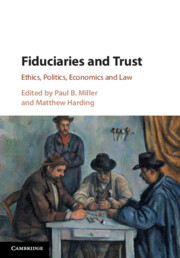Book contents
- Fiduciaries and Trust
- Fiduciaries and Trust
- Copyright page
- Dedication
- Contents
- Contributors
- Acknowledgements
- Introduction
- Part I Personal Trust and Fiduciary Relationships
- Part II Personal Trust and Fiduciary Duties
- Part III Political Trust and Fiduciary Government
- Part IV Trust and Fiduciary Law in Context
- 13 For-Profit Managers as Public Fiduciaries
- 14 Fiduciary Law and the Preservation of Trust in Business Relationships
- 15 How Much Trust Do Trusts Require?
- Index
15 - How Much Trust Do Trusts Require?
from Part IV - Trust and Fiduciary Law in Context
Published online by Cambridge University Press: 13 March 2020
- Fiduciaries and Trust
- Fiduciaries and Trust
- Copyright page
- Dedication
- Contents
- Contributors
- Acknowledgements
- Introduction
- Part I Personal Trust and Fiduciary Relationships
- Part II Personal Trust and Fiduciary Duties
- Part III Political Trust and Fiduciary Government
- Part IV Trust and Fiduciary Law in Context
- 13 For-Profit Managers as Public Fiduciaries
- 14 Fiduciary Law and the Preservation of Trust in Business Relationships
- 15 How Much Trust Do Trusts Require?
- Index
Summary
Some interpersonal interactions involve substantial trust, while others do not. The interaction between an infirm, elderly parent who needs personal care or management of assets and an adult child who undertakes to provide it is an example of a relationship that typically involves substantial trust. Some other interactions, however, even long-term interactions or those between repeat players, can require much less trust because the terms of the arrangement are specific and entail strong verification protocols. This chapter focuses on the trust, in the precise legal sense of that term, and the relationship between the trustee of the trust and the trust’s beneficiaries and settlor. To what extent does trusteeship in the legal sense require trust in the general sense? The chapter examines the features of the express trust under modern U.S. law and practice that would seem to require there to be a significant degree of trust in the trustee by the trust’s beneficiaries and/or settlor. The paper also examines the features of modern U.S. trust law and practice that attempt to protect the trust’s settlor and/or beneficiaries so that they need not place worryingly high levels of trust in the trustee.
- Type
- Chapter
- Information
- Fiduciaries and TrustEthics, Politics, Economics and Law, pp. 316 - 331Publisher: Cambridge University PressPrint publication year: 2020



